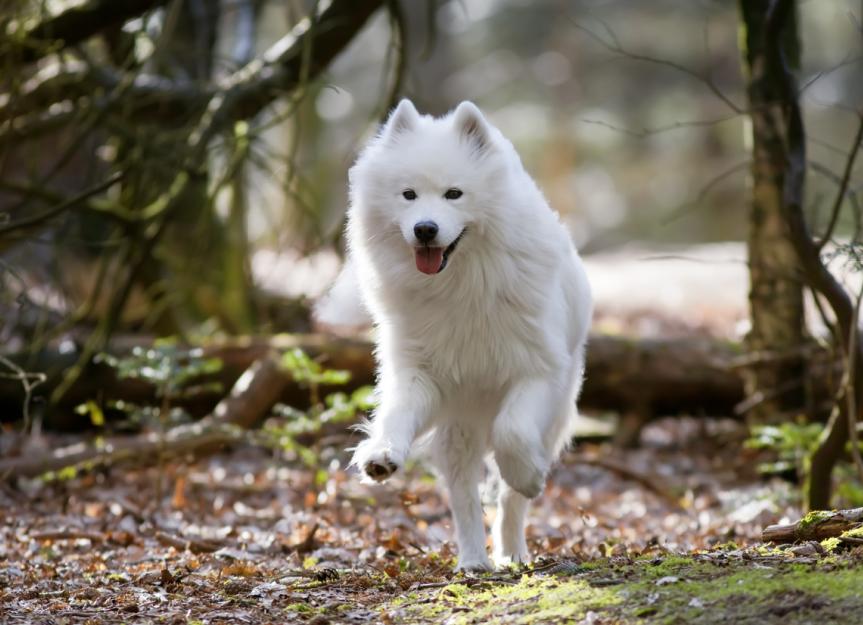Samoyed
The following may contain Chewy links. PetMD is operated by Chewy.
The Samoyed is best known for its pure-white fluffy coat, curled fluffy tail, friendly personality, and love of cold weather. These dogs are built for herding and working in extremely cold climates, and are direct descendants of the Reindeer Spitz from Russia. Samoyed is another name for the Nenets people, who are native to the extreme northern part of Russia.
Samoyeds have a very thick, two-layer hair coat that consists of a long straight-haired topcoat and a dense soft undercoat. They are medium- to large-sized dogs (35-65 pounds) with a confident stance; triangular, thick, rounded ears; curved mouth corners that appear to create a smile but were actually bred to prevent icicle buildup; a deep chest; strong, long hind legs; and a fluffy curled tail that rests on their back.
Caring for a Samoyed
The Samoyed has a friendly, playful, alert temperament and can make a great companion and family dog. Because of their thick, double-layered hair coat, Samoyeds require regular brushing and do not do well in warmer temperatures. Pet parents should be aware that a Samoyed can developheatstrokein warmer climates, or even during spring and summer in temperate weather zones.
The Samoyed is a powerful working dog and does not tire easily. These dogs are most known for pulling sleds, herding, agility, and hunting. They need regular exercise and are very playful, active dogs who love to be social with people and other dogs.
Samoyed Health Issues
While the Samoyed can live a long life—up to about 14 years—they can be genetically predisposed to several medical issues, including eye and heart problems, hip dysplasia, and kidney disease. Their sensitivity to warmer temperatures can lead to other medical issues.
Retinal Diseases
The retina is in the back of the eye; it senses light and sends information to the brain for visual recognition. Two retinal diseases often found in Samoyeds are:
Retinal dysplasia, which occurs when abnormal folds in the retina lead to decreased vision and eventually blindness. In Samoyeds, retinal dysplasia can be a genetic disease, and can be screened with a DNA test.
Progressive retinal atrophy (PRA), a genetic disorder that causes the light sensors of the retina (photoreceptors) to die, leading to blindness in the young to middle-aged Samoyed. There is also genetic DNA testing available to screen for PRA.
While there is no specific treatment available for genetic-linked retinal diseases in dogs, gene therapy may be an option for treatment.
Uveodermatologic Syndrome
UDSis a skin and vision disease where a dog’s own immune system abnormally attacks melanin production. Melanin is responsible for the various pigment shades of the skin and hair, and certain structures of the eyes. UDS can cause various skin lesions and lightening of the skin (depigmentation), along with inflammation in the eyes and vision problems. Treatment of UDS typically involves steroids and/or cyclosporine to help suppress the immune system response.
Heart Problems
The Samoyed can be predisposed to several heart problems, including the following:
Atrial septal defect(ASD) refers to a hole between the left and right atria of the heart, two of the heart’s four chambers. During embryo development prior to birth, a hole is naturally present between the left and right atria, but it should close as the embryo grows. If this hole is still open after birth, it may cause abnormal blood flow in the heart and can ultimately lead to heart failure. ASD is not common and may not cause any obvious problems for a dog who has it.
Aortic stenosis refers to a narrowed opening of the aortic valve in the heart, which develops as the dog ages. While aheart murmurmay be observed on a physical exam by a veterinarian, this condition often does not cause any major issues, and the dog can live a normal life. However, with severe aortic stenosis, clinical signs such as lethargy, shortness of breath, coughing, or collapse may occur. Treatment of clinical signs associated with severe aortic stenosis may include exercise restriction and daily heart medication, such as a beta-blocker. Surgical intervention with placement of a specialized balloon (known as balloon valvuloplasty) may also be a treatment option.
Pulmonic stenosisis a congenital disease that involves a narrowing of the pulmonic valve in the heart. Similar to aortic stenosis, pulmonic stenosis may or may not cause clinical signs of lethargy, shortness of breath, coughing, or collapse. Balloon valvuloplasty is often the treatment of choice in severe cases of pulmonic stenosis, but other surgical options are possible.
In general, any heart problem diagnosed by a veterinarian (usually from hearing a heart murmur on a physical exam) should be monitored every 6-12 months with an echocardiogram (heart ultrasound) and chest x-rays.
Hip Dysplasia
Hip dysplasia是一个条件的髋关节不有趣吗ction properly and can cause pain. While there is a genetic predisposition to this condition, lifestyle habits and certain factors—including a Samoyed’s growth rate, muscle mass, diet, and exercise—can contribute to the development of hip dysplasia.
Testing is available (PennHIP screening) to detect the likelihood that dogs will develop hip dysplasia in their lifetime. If your dog is diagnosed with hip dysplasia, there are a few options for treatment and long-term management, including medications, joint supplements, and surgical intervention. Weight management is also important.
Samoyed Hereditary Glomerulopathy
SHG is a genetic kidney disorder often seen in Samoyeds. It affects the glomerulus, which is the kidney filter. When the glomerulus is affected by SHG, proteins from the blood, such as albumin, will spill over into the urine. Over time, destruction of the glomerulus will lead to kidney failure, which usually occurs by age 5 for a Samoyed with SHG.
There is a genetic DNA test available for SHG. While there is no specific treatment or cure, certain ACE-inhibitor medications and high-quality, protein-restricted “kidney-friendly” diets may help slow disease progression.
What to Feed a Samoyed
A Samoyed less than a year old needs a high-quality puppy food approved by theAssociation of American Feed Control Officials (AAFCO).Older Samoyeds (7 years and up) should be offered a high-quality senior food that is also AAFCO-approved.
Samoyeds who are involved in routine herding, sledding, or other strenuous exercise need a high-quality dog food with a greater protein content than what would be offered for a typical house dog. For a less active family companion, overfeeding or offering excessive amounts of treats during the day should be avoided to preventobesity.
As previously mentioned, a Samoyed with SHG should be fed a high-quality, protein-restricted, “kidney-friendly” diet to help slow disease progression.
How to Feed a Samoyed
As with most dog breeds, it’s appropriate to feed an adult Samoyed twice a day, in the morning and evening. Fresh water should always be available.
How Much Should You Feed a Samoyed?
In general, the amount of dog food offered should be based on the ideal weight of the adult Samoyed, which is typically 35-65 pounds. For most commercial dog foods, refer to a feeding guideline printed on the package. Your veterinarian can also work with you to determine the appropriate amount of food per day for your Samoyed.
For Samoyed puppies, the amount of puppy food offered is based on their weight.
Nutritional Tips for Samoyeds
For very active Samoyeds, consider addingglucosamineand omega-3 supplements (such as fish oil) to their food to promote joint health. There are also some commercial joint-health dog foods available that contain added omega-3 and/or glucosamine.
Behavior and Training Tips for Samoyeds
Samoyed Personality and Temperament
The Samoyed has a friendly, playful, alert temperament and can make a great companion and family dog. These dogs are very vocal and will bark, growl, and whine, especially when they're excited and playing. They usually love meeting new people and other dogs.
The Samoyed is a very energetic dog breed that thrives on exercise and playtime. Because of their high-energy, friendly personality, it’s important to keep Samoyeds in a fenced yard or walk them on a leash so they don’t wander away.
Samoyed Behavior
Because of their high energy and desire to work, the Samoyed needs consistent exercise and plenty of space to work and play. A Samoyed that feels confined or bored may become destructive and anxious.
Samoyed Training
As with most other breeds, Samoyeds respond best to training and socialization early in their puppy life. The Samoyed is a smart dog that typically responds well to training. They thrive on performing active tasks and can be fully trained to herd other animals, pull dogsleds, and do agility training.
Fun Activities for Samoyeds
A long walk or run
Sledding
Agility
Weight pulling
Herding
Frolicking in the snow
Samoyed Grooming Guide
The Samoyed has a very thick, two-layer hair coat that consists of a long straight-haired topcoat and a dense soft undercoat. These dogs have a moderate shedding level and require regular brushing.
Skin Care
Regular bathing is not required for Samoyeds unless they become soiled or covered in outdoor debris. Care should be taken to dry the Samoyed’s hair coat with a large towel or hair dryer on a low setting after bathing.
Coat Care
Regularly brushing the Samoyed’s hair coat will help to maintain its integrity and beauty. A de-shedding brush (such as theFURminator) can help remove excess undercoat, especially during warmer months.
Eye Care
Because Samoyeds may be prone to certain eye problems, it’s important to have their eyes examined at least once a year by a veterinarian.
Ear Care
After every bath, splashing in water, or rolling around in the yard, Samoyeds should have their ears cleaned with a dog-specific ear cleaner.
Considerations for Pet Parents
的一些主要考虑宠物的父母啊f a Samoyed include sensitivity to warmer temperatures; the need for lots of exercise and socialization; and a potential genetic predisposition to eye problems, heart problems, hip dysplasia, and kidney disease.
These considerations are important because they can greatly affect the overall lifestyle of the Samoyed. A Samoyed living in an apartment in a hot climate will not thrive nearly as well as one living on a large property in a snowy climate.
Pet parents considering the Samoyed breed should consider getting pet insurance to help handle potential medical costs associated with genetic diseases.
Samoyed FAQs
Is a Samoyed a good family dog?
是的!Samoyeds make excellent family companions, especially with children and other pets. They are very active, social, friendly, loving dogs.
Are Samoyeds smart dogs?
Absolutely! Samoyeds love to be trained to perform a task.
What are the drawbacks of a Samoyed?
Samoyeds require lots of exercise, regular coat brushing, and tasks to keep them busy and happy. Some pet parents may have difficulty meeting these needs, especially those who reside in a hot climate, live in an apartment, work long hours away from home, or don’t have a very active lifestyle.
How much does a Samoyed cost?
When purchased through a breeder, Samoyed puppies can cost as much as several thousand dollars, especially if they have AKC registration. However, there are Samoyed rescue organizations that have young to older adults (and sometimes puppies) available for adoption at lower costs. Likewise, some animal shelters may have Samoyed puppies or adults available for adoption.
Is a Samoyed part wolf?
All dog breeds have a common ancestral descendant in the wolf. The Samoyed is a breed of dog and is not considered to be part wolf.
Is a Samoyed a Husky?
No, the Samoyed is a different dog breed. It is a direct descendent of the Reindeer Spitz dog breed from Russia.
Can a Samoyed live in a house?
是的!特别是在极端热或冷的时候,the Samoyed can be kept mostly indoors. While Samoyeds are very acclimated to cold climates, they still require appropriate shelter from extreme temperatures and weather conditions. With any Samoyed, kept indoors or outdoors, it is imperative to provide plenty of opportunities for exercise during the day.
Featured Image: iStock.com/BoValentino

